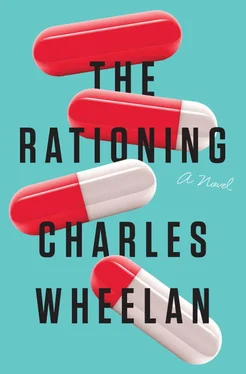The Speaker’s top legal adviser, who had been following her around silently like a lapdog ever since she attended her first meeting, nodded in agreement. The Speaker stared malevolently at the President. “You are making a huge mistake,” she said. “Thousands of people are going to die, and it will all be on you.”
“I haven’t decided anything yet,” the President said. “But as always, I appreciate your input.” The Speaker turned abruptly and walked away. We do not know exactly where she went, or who she called. We do know that shortly thereafter, Claire Yegian, the most notoriously dogged member of the White House press corps, texted the Communications Director for a comment on “the Hawaii tragedy” with a link to a local news story: three children, all under seven, had died from “flu-like symptoms.” Their father, a widower who had moved the family from Cleveland to Honolulu for a new start after his wife was killed in a car accident, was demanding an investigation. The tragedy of three dead children, combined with the father’s allegations that some dangerous disease was afoot, was getting traction.
The Communications Director texted back, “President sends deepest condolences, but this is clearly not WH [White House] business.”
Yegian’s chilling response came right back: “I have it on highest authority that it is.”
The Communications Director called her. “Who’s your source?” he asked, without exchanging pleasantries.
“Give me a break,” Yegian said, miffed that he would even ask.
“Then let me ask you this: Might it be someone who wants to run for president herself?”
“Something’s going on,” Yegian insisted. “That I know. Now I’ve got three dead kids under strange circumstances and a high-level source saying the White House knows something—”
“You can’t corroborate that,” the Communications Director said tersely.
“Not yet.”
“The President sends his deepest condolences for this family tragedy,” the Communications Director said, and then hung up. He walked quickly to the corner of the room where the President was speaking with the First Lady. I had not noticed her come in; this was the first time I had seen her in person. She was taller than I thought, maybe because of the heels, and elegantly made up, with dark black hair pulled back in a tight bun. She was wearing large diamond stud earrings. Later, when she appeared in public, they would be gone. I was watching the couple from across the room, unaware of what they were talking about, when the President wheeled in my direction and pointed at me. There was fierceness in his eyes, more than just anger, that I had not seen before. “I thought you said this was like the flu,” he said loud enough to stop other conversations. I found myself walking, almost involuntarily, to where the Communications Director was huddled with the President and the First Lady. “Three kids—three little children—all dead. That’s not the flu,” the President repeated as I joined them.
“Focus,” the First Lady snapped at him. And then, more calm and measured: “These things happen. Tragedies happen.” In that moment I appreciated what it means to be the partner of someone who carries the weight of the White House.
“The Speaker is leaking like a sieve,” the President said angrily. “Now goddamn Claire Yegian—”
“You just need time, honey,” the First Lady said. “I can buy you time.”
“Three children?” the President repeated. “The guy loses his wife and then all of his children? That’s not the flu… His whole family.”
“Did they seek treatment?” I asked. The President ignored my response. The Communications Director shook his head no, leaving me confused as to whether he was answering my question or trying to tell me to stop talking.
“Do you have any idea how bad this could get?” the President asked. We all recognized it as a rhetorical question.
“You need to keep doing what you’re doing,” the First Lady said, almost sternly. I realized that the architect of the “Mac ’n Cheese Massacre” was no stranger to hard decisions, if in less deadly situations. “Okay?” she added.
“I think this is a bad idea,” the Communications Director said.
“Nobody asked you,” the First Lady answered. Under different circumstances this might have been funny, as the Communications Director’s entire job consisted of offering advice on these matters.
“Are you sure?” the President asked.
“Twenty minutes,” she replied.
Having walked into the conversation, I had no idea what was afoot. But roughly twenty minutes later I understood. The First Lady held an impromptu news conference on the White House lawn. “I have just two short statements,” she began. “First, the President and I would like to extend our heartfelt condolences to Cliff Barnhill for his tragic loss in Honolulu. The President and I read this story and were so deeply saddened. Please, please let this be a reminder to all Americans to seek treatment immediately if you feel ill—always better to err on the safe side. The flu season is not over, and we are working with Hawaii public health officials to learn why the illness was so virulent in the Barnhill case.
“Second, the President and I will be spending some time apart.” There was an audible gasp from the assembled press corps. The photographers and camera operators pressed closer. “I will be leaving immediately to spend time with my parents in New Hampshire. I would ask that you respect our privacy with regard to this situation.” She paused and grasped the podium, as if for emotional support. One of the photographers, paid to notice the small things, realized that she was not wearing her wedding ring. He moved toward the podium and shot a close-up of the ringless finger. It was unseemly, so close that a pale band was visible where the ring had shielded her finger from the sun, but this was the money shot. Home Depot Media began blasting out the image three minutes later.
The First Lady’s motorcade left the White House with a parade of media vehicles in tow. Claire Yegian’s editor texted, “Go to NH.”
THE STRESS AND FATIGUE WERE EVIDENT AROUND THE CONFERENCE table. On breaks, the White House staff would swoop in to clear away plates and cups, but the room still had the stale feel of a common area in a college dormitory during finals. The Majority Leader had finally taken off his jacket. The Strategist had loosened his tie and unbuttoned the top button of his shirt. The room was cool, but many of us looked like we had been sitting in the same place for too many hours (and probably smelled that way, too). I wanted real food, some exercise of any kind, and a shower. It was not going to happen anytime soon. As soon as I left the room, I would have to get on a plane and fly to New Hampshire.
The Chief of Staff called us back to order. “I want to thank the Acting Secretary for bringing up the issue of how we might distribute our stock of Dormigen if we were to come up short,” she said. “I know we hope it will not come to that, but I agree that we ought to plan for every contingency.”
“Don’t we have some system for allocating scarce medicine?” the Strategist asked.
“No,” the Acting HHS Secretary said. “We have situations where individuals cannot afford the medicines that are available, but we do not have any policy governing scarcity. It’s just not something that typically happens.”
“What about donor organs?” the Strategist asked.
“That’s a whole separate system that has a lot to do with matching the tissue type of donors and recipients. It really doesn’t offer us much guidance.”
“So how do we distribute Dormigen right now?” the Strategist asked. It was interesting to watch his mind work, like a precocious child who cannot help but ask more questions. Others in the room were clearly eager for the Acting Secretary to start his presentation, but the Strategist was oblivious to the looks that were being exchanged across the table.
Читать дальше












